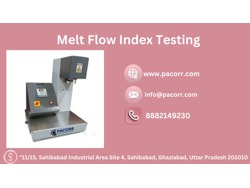Introduction
The Melt Flow Index (MFI) Tester is an essential tool in the polymer industry, providing critical data that helps manufacturers ensure the quality and consistency of their products. This article delves into the importance, working principles, and applications of the Melt Flow Index Tester, offering a comprehensive understanding of why this device is indispensable in polymer testing.
What is a Melt Flow Index Tester?
A Melt Flow Index Testing, also known as a Melt Flow Rate (MFR) tester, measures the rate at which a thermoplastic polymer flows under a specific load and temperature. The test results provide valuable insights into the material's viscosity and flow properties, which are crucial for determining its suitability for various applications.
In the world of polymer manufacturing, precise testing and quality assurance are paramount. One crucial instrument in this field is the Melt Flow Index (MFI) Tester, a device designed to measure the flow rate of molten plastics. This tool plays a significant role in ensuring that plastic materials meet the required standards for various applications, from packaging to automotive parts.
What is a Melt Flow Index Tester?
The Melt Flow Index Testing, also known as a melt flow rate tester, is used to determine the viscosity of thermoplastic polymers during the melting process. It measures the rate at which a polymer sample flows through a capillary die under specific conditions of temperature and load. The result is expressed in grams per 10 minutes (g/10 min), providing a quantitative measure of the polymer's flow characteristics.
Why is the Melt Flow Index Important?
The Melt Flow Index Teste is a critical parameter in polymer processing because it directly influences the material's processability. A higher MFI indicates a lower viscosity, suggesting that the polymer flows more easily when melted. Conversely, a lower MFI indicates higher viscosity, meaning the polymer is more resistant to flow. Understanding this characteristic helps manufacturers select the right material for specific applications and optimize processing conditions such as temperature and pressure.







